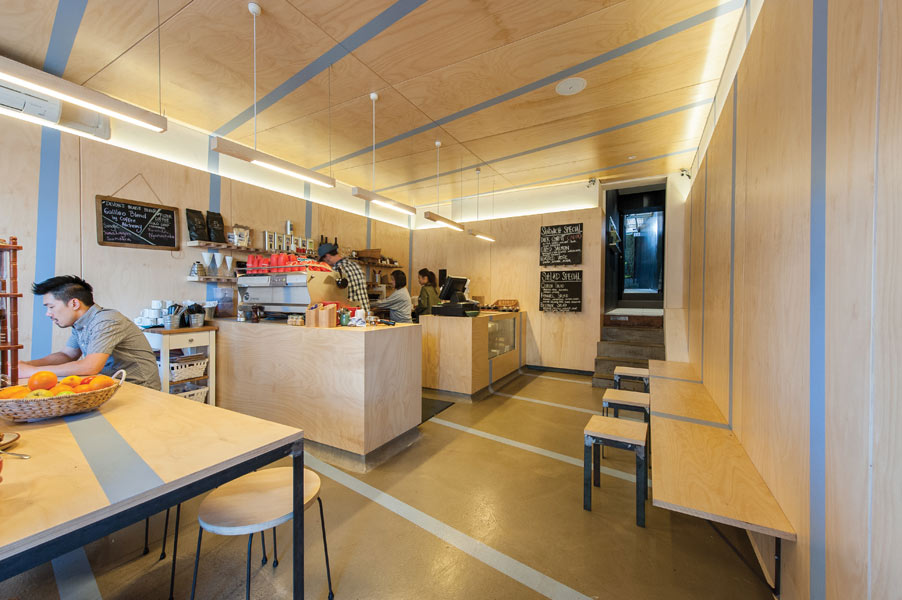
Green scene
Share
Above: The green wall at Newtown Social Club, designed by Matt Woods Design, regulates air quality and acoustics in the venue
“I don’t have the so-called sustainability discussion with my clients anymore,” says Matt Woods, principal of Sydney-based design firm, Matt Woods Design. “It’s in my DNA to produce sustainable work. It’s integral to what I do.”
Woods, who holds a degree in industrial and sustainable design, is well-known for his standout interiors that often result from the creative and unexpected combination of reclaimed and off-the-shelf materials. “Yes, I specify eco-friendly materials wherever possible and appropriate,” he adds, “but it’s more than just material selection. Every design is a holistic set of choices that includes maximising space in terms of orientation, layout and existing character. Because these factors play a critical role in the overall design, I discuss them in detail with my clients early on in the process, so that they know where I stand.”
Fortunately, Woods is finding an increased desire among his clients for environmentally responsible design. “Part of what attracts us to Woods’ work is his simple, pragmatic and responsible approach,” explains Jack Martin, part-owner of Newtown Social Club. Martin recently commissioned Woods to create an interior fitout for the newly opened pub and soon-to-be music venue, in Sydney’s inner- west. “We had many discussions about issues such as life cycle versus cost. We know that cheaper isn’t always better and we gave Woods the freedom to propose appropriate substitutes.”
While environmentally aware clients may be a growing trend, are they actively seeking out so-called ‘sustainable’ designers? “We find that that are,” says Clinton Cole of CPlusC, a boutique architecture and construction firm based in Sydney. “Of late, our clients have cited sustainability as their key criterion in selecting a designer. Where we once had requests for a solar panel here or there, we now find that our clients are really embracing a holistic approach to sustainable design.”
And yet, while clients are responding to environmentally considerate design, the higher cost of some eco-friendly options is still proving a deterrent. “Price is an issue,” adds Woods. “For example, the reclaimed timber flooring I specified at Newtown Social Club was double the price of a similar, non eco-friendly option. But it was an important – and integral – component of the design and I elected to cut and skimp in other areas of the budget. It’s a constant trade-off.”
Fortunately, Woods was still able to integrate a green wall into the space, which regulates the pub’s internal air quality and offers much- needed acoustic insulation. “It also helps that it’s a beautiful element,” he adds.
There’s no doubt that aesthetics play a role. “The notion that a sustainable design will look bland or unsophisticated is very outdated,” adds Oliver Davis, a Melbourne- based interior designer with a degree in sustainable development.
“I recently specified handcrafted, FSC certified timber sofas in organic fabrics and a stunning feature rug, accredited by the Fairtrade label STEP. The clients weren’t specifically seeking a sustainable fitout, but they were willing to pay a premium for beautiful, well-made pieces. They needed no convincing because the aesthetics of the products spoke for themselves. We need to show clients that sustainable can be beautiful.”
It’s an ongoing designer-client discussion, one that is certainly gaining traction as more and more manufacturers and suppliers are jumping on the ‘green’ bandwagon. “But it’s also about acknowledging the evolving nature of design,” adds Woods.
“At Newtown Social Club, we needed to design around the possibility of an added second storey. We decided where the stair would be placed [in the future] and designed all the components in that area to be easily demountable. It’s always important to understand – and design for – your clients’ future plans.”
It’s an approach that Melbourne design firm, Hecker Guthrie, adopts on a regular basis, particularly when it comes to designing and integrating bespoke joinery and interior furnishings. “We tend to design freestanding elements that can be moved and reused in the future,” Hecker Guthrie co-principal Hamish Guthrie explains. “We also try to avoid too many fixed wall linings, encouraging our clients to be more adventurous in their loose fittings and furnishings, which can be adapted and changed more easily over time.”
Woods frequently adopts a similar approach, in which the existing bones of an interior are left as is. “I often use the existing character of the space to influence the look and feel of the design,” he says. “For example, we’ll remove render or cladding to discover that the resulting walls are beautiful in their own right.”
This inherently green strategy is defined by considered resourcefulness – retaining existing floors, wall tiling and exposed structural elements. At Newtown Social Club, Woods simply painted the existing steel truss work black, creating a strong graphic feature against the modest FSC plywood-clad walls and ceilings.
“Clients often request ‘faux’ environments – over-designed interiors that are simply inappropriate in terms of context, budget and the environment,” he adds. At Devon Cafe in the Sydney suburb of Surry Hills, Woods used camouflage netting to differentiate spaces within the deeper recesses of the cafe – an affordable, easily demountable and striking solution that creates an urban yet green oasis in the cafe.
“I’ve learned to push back on requests that I felt weren’t appropriate and to respond with a simpler approach,” he adds. “It’s our responsibility to show our clients that there are alternatives that will serve them – and the environment – better.”
killingmattwoods.com
cplusc.com.au
oliverdavis.com.au
heckerguthrie.com

















